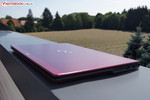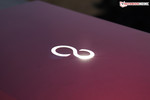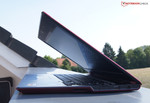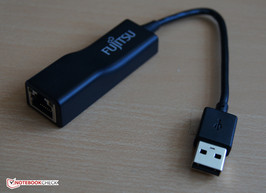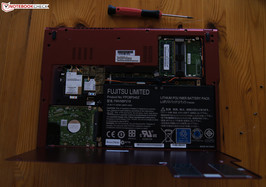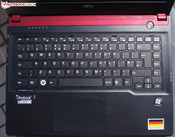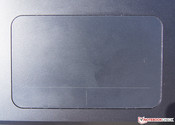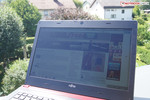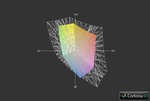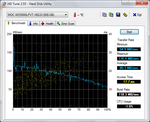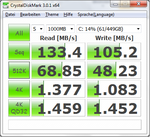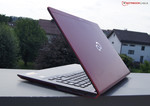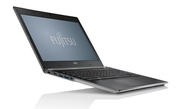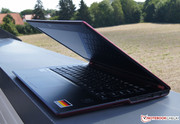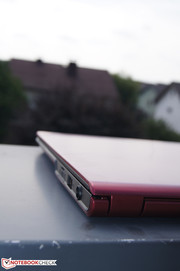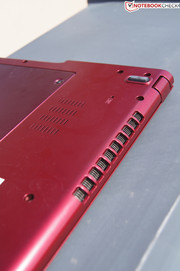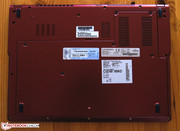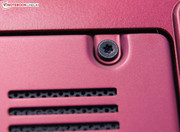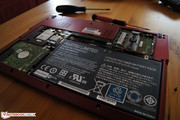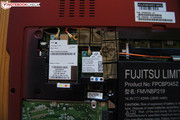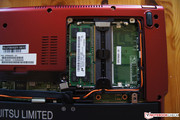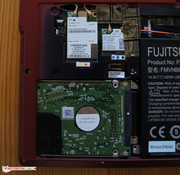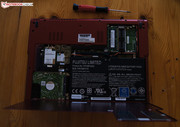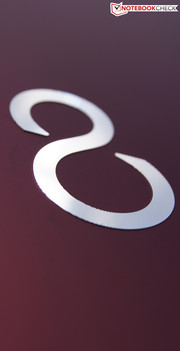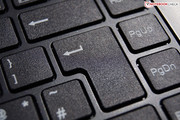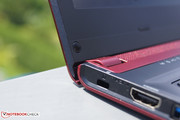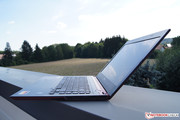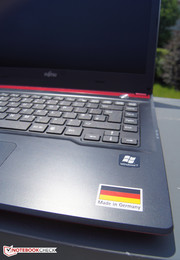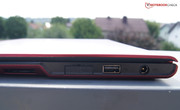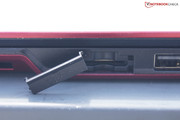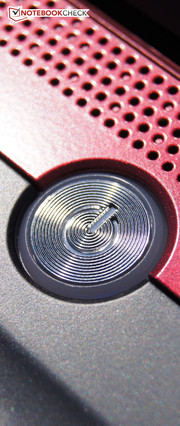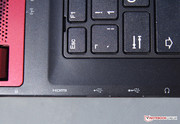Review Fujitsu LifeBook UH572 Ultrabook

Fujitsu took its time in releasing a cheap, full-fledged ultrabook onto the market. There are many interesting devices in the entry-price range of 700 Euro (~$877) and ultrabooks that cost far more than twice as much. In addition to our test device, Fujitsu also builds the Lifebook U772. It competes against more expensive opponents with an entry-price of 1200 Euro (~$1503) and a 14-inch screen in a 13-inch case.
Our Lifebook UH572, priced at 799 Euro (~$1001), is to compete against cheaper opponents such as Lenovo's U310, HP's Folio 13 or Acer's Aspire S3. They are all good value for money entry-level ultrabooks and can, though not uncompromisingly, convince in their own way. Fujitsu's main argument against these slim devices is mobile broadband, covered by Sierra Wireless' Gobi 3000 HSUPA modem in the Lifebook UH572. Let us take a closer look at the device's other qualities.
Case
Most of our attentive readers likely know which specifications a modern ultrabook has to fulfill. Such a device has to particularly feature a light, slim, appealingly designed case that is rigid so that it can be used as a robust traveling companion. Moreover, it should sport a good battery life and a bright screen. Fujitsu does not have to redefine this category or customer wishes - long have a few manufacturers gathered experience in the field of ultrabooks. Thus unsurprisingly, Fujitsu does not tread new paths with the UH572's chassis. Nevertheless, Fujitsu's interpretation impresses right away.
Our version features a nicely shimmering metallic red magnesium case - however you can naturally choose a less striking silver color. The lid's surface is processed and painted so meticulously that it looks like colored aluminum under light. In addition to the slim, almost fragile appearing build (18 mm height (0.71 inches) - closed), the used material allows an impressive case stability at a weight of merely 1.57 kilograms (3.46 pounds). Even greater effort does not really warp or dent the base or even the lid, which is very rigid considering its thin build. Of course, the manufacturer has designed everything according to this slim size and light weight - but not without advantages and disadvantages that will still be seen.
The case is manufactured very well and feels agreeably soft. The edges and corners are ergonomically flattened in important places. Opening the device also proves to be very easy even with one hand. The lid can be opened to an angle of 145° and is held firmly by the two small hinges without rocking noticeably. The ruby-colored lid and base alternates with matte black on the input field. Their surface does not look as rubberized as do various ThinkPads, but is rather smooth. The designers considered usability here: The interfaces on the sides are marked on the top's right and left edge so that they are easily found.
Connectivity
Meanwhile most manufacturers install all important interfaces even in budget ultrabooks. Thus, Fujitsu builds everything of distinction into the UH572.
In addition to a Kensington lock, the HDMI port for connecting the flat screen at home and two USB 3.0 ports are on the left. Since both USB ports are quite close to each other, broad flash drives may cover the neighboring port.
Fujitsu installs the former USB 2.0 standard and the power socket beside a SD/MMC/Memory stick card reader on the case's right. A plastic flap is seen when looking closer at the right. It covers the SIM card slot for the UMTS modem. If you are missing a LAN port in our list, it is available as a USB-to-RJ45 connector because, according to Fujitsu, it would not have fit into the slim case. Unlike its more expensive U772 brother model, the UH572 does not feature a docking port.
Communication
In addition to WLAN via Intel's Centrino Wireless-N 2230 (b/g/n), cabled network connections are also possible via a USB-to-LAN connector. However, a highlight of the low-priced UH572 is definitely the option of surfing on the Internet via HSUPA using mobile broadband. In addition to Bluetooth 4.0, Intel's WLAN module offers other technologies such as Wireless Display. Thus, wireless transmission of screen content to a compatible monitor or TV is possible.
Security
Apart from the slot for notebook locks, we unfortunately did not find any relevant security features on the UH572. Thus, the device can only be protected against theft at work. Fujitsu adds more such features in its U772 business ultrabook.
Accessories
Apart from the notebook, LAN connector and various instructions, we also find two recovery DVDs in the box. They enable resetting the ultrabook to state of delivery - providing that an external DVD drive is available because ultrabooks lack this equipment. Unlike the bigger U772 model, the UH572 does not feature a docking port. Thus, Fujitsu's accessories range from notebook cases to external hard disks and external input devices.
Maintenance
We were very pleased about the huge maintenance cover on the bottom of the ruby-red magnesium ultrabook. Merely 6 Torx screws separate the experienced user from replacing or expanding a few components. They are Western Digital's 500GB, 2.5-inch hard disk, the RAM (only one of two banks occupied with a 4GB, 1600 MHz DDR3 module), the Wi-Fi card and Sierra's UMTS module (both connected via mini PCIe) in the UH572.
Warranty
Fujitsu delivers the Lifebook with a standard 12 month collect & return service. We did not find any extension options on the manufacturer's homepage. Too bad, since a few competitors offer warranty extensions.
Input Devices
As seen in our recent review of the U772, it is not exactly the input devices that cover Fujitsu's new ultrabook with glory. Will this be different in the UH572?
Keyboard
Compared with the U772's keyboard unit, it is fairly good but far from being a paragon.
Typing is comparatively easy on this model. The key drop is short, but much better than in the significantly more expensive U772. The subjective typing feel conveys accuracy but the keyboard makes an extremely low-end impression. The entire chiclet keyboard unit seems to fit somewhat loose in the base. Thus, the construction clatters and "clicks" with every key stroke, no matter how gently pressed, and it also yields evidently. This reminds us of first generation netbook keyboards.
But not everything is bad about this keyboard. The pressure point is relatively crisp. Considering the price or the U772's unusual keyboard, the unit installed here is satisfactory. Typos are hardly an issue and the ergonomics are acceptable. Nevertheless it is disappointing when compared with input devices of recent contenders. We can recommend both the backlit keyboard of HP's Folio 13 as well as the "conventional" yet excellent keyboard in the IdeaPad U310. Unfortunately, the Aspire S3 offers a keyboard similar to the one installed here.
Touchpad
The Lifebook's mouse replacement is very similar to the one in the U772. Ergo it adopts all traits and problems but additionally exhibits a similar, clattery noise as perceived from the keyboard.
The inherited traits include the touchpad's rather smooth surface where you occasionally snag and the fairly unreliable keys' functionality. As it is so often seen in ultrabooks, the pad's touch-sensitive surface extends over the area of the left and right key. They are no longer dedicated and the entire touchpad can be pressed to perform clicks. However, our model exhibits a slightly unusual behavior here. The UH572 pad's outermost right and left corners, where we normally press to click, respond just as little as those in the U772. We had to press the buttons' center area hard to trigger the clicks. However, they were sometimes assigned to the wrong key - more often than not, a context menu popped up after an intended left click. Multi-touch gestures, such as the popular two-finger scrolling, work well. However, they have to be enabled via the driver menu instead of in the lower right task bar as would be usual.
Display
While all ultrabook models in this comparison rely on glossy-type screens using the same resolution of 1366x768 in a 13.3-inch screen size, our Lifebook's matte version stands out a bit from its high-gloss contenders. The UH572's matte TN screen (LP133WH2-TLM3) comes from LG and takes up the fight against reflections indoors and out.
However, it struggles with the very often criticized flaws of such low-end screens. The average brightness of 177.8 cd/m2 (max: 196.5 cd/m2) cannot be recommended for outdoor use because the content simply looks too dark in bright surroundings.
| |||||||||||||||||||||||||
Brightness Distribution: 80 %
Center on Battery: 189.2 cd/m²
Contrast: 158:1 (Black: 1.2 cd/m²)
| |||||||||||||||||||||||||
Brightness Distribution: 76 %
Center on Battery: 192 cd/m²
Contrast: 194:1 (Black: 0.99 cd/m²)
Seen subjectively, it is a screen suitable for Internet surfing and Office tasks that do not require high color intensity.
The measured rates confirm our impression of the low contrast. A too high black value only results in a weak contrast. The reproducible color spectrum is very limited. Here, like in the comparable competition, not even the sRGB standard is achieved. Consequently, the Lifebook is not suitable for graphic designers and photographers - but they will likely turn to specialized professional devices anyway.
If you are looking for an outdoor-suitable screen in an ultrabook and want a higher resolution, you will have to invest an additional 300 Euro (~$376) or more. Devices like the Zenbook UX32VD or Samsung's 900X3B offer these qualities. However, the Lifebook UH572's matte screen represents an interesting alternative to the glossy-type screens of the contenders of the 800 Euro (~$1002) price range.
Performance
Fujitsu basically offers its Lifebook UH572 in two configurations. We are testing the fairly low-priced 799 Euro (~$1001) alternative that features Intel's Core i5-3317U (2 x 1.7 GHz - 2.6 GHz) and a 500GB Western Digital hard disk which is fired up by a 32GB SSD cache. If you invest 150 Euro (~$188) more, you get a very fast, pure-bred 128GB SSD and a faster Core i7-3667U CPU (2 x 2 GHz - 3.2 GHz). Both versions include the same graphics solution in the form of Intel's HD Graphics 4000.
The price-performance ratio is first-rate in both versions. However we would sooner take the cheaper UH572 alternative because there are ultrabooks with better screens and input devices for just under 1000 Euro (~$1253).
When we take a look at the contenders in this comparison, we notice that the IdeaPad U310 also complies with Intel's minimum specifications regarding storage devices, so a similar array of 500GB HDD and 32GB SSD cache. Acer's S3 also uses a 320GB HDD + 20GB SSD. Merely the Folio 13 sports a swift 128GB SSD from Samsung and thus will likely be a tough opponent particularly in terms of system performance.
Processor
The core of our Lifebook UH572 is a very energy-efficient ULV (ultra-low voltage) processor from Intel's latest Ivy Bridge generation specified with a TDP of 17 Watts - the Core i5-3317U to be precise. It offers a default clock of 2 x 1.7 GHz. However, the single cores can be overclocked up to 2.6 GHz depending on the processor's load owing to Turbo Boost 2.0. In addition to this technology, Intel's CPU also supports Hyperthreading, which enables processing two threads on one processor core per clock simultaneously. This is also the reason that a dual-core CPU, such as the i5-3317U, shows four performance diagrams in the task manager rather than two as would actually be expected.
The processor even manages to outperform a few older Core i7 ULV CPUs due to this and various other improvements of the Ivy Bridge processor generation. Thus, it should also have enough power reserves for all routine scenarios and even allow occasional video editing (although there are much more suitable devices for this purpose).
Lenovo relies on exactly the same CPU and GPU (HD Graphics 4000) in the IdeaPad U310. Consequently we should find a good basis for comparison here. HP's Folio 13 and Acer's Aspire S3 both use the outdated Core i5-2467M featuring the integrated HD Graphics 3000. A look at the measured performance rates of CineBench R11.5 (CPU multithread) shows that our test device is inferior to the IdeaPad by 18%. It is even 22% below the Folio 13 although it uses an actually slower processor from the former Sandy Bridge generation. Acer's S3 is also 21% faster. The screenshot (upper right) is to illustrate why poorer results are achieved. The Lifebook exhibits reproducible clock rate decreases in CineBench R11.5 (multi). Thus, the clock frequency of both cores is reduced from 2.4 GHz to 800 GHz about every two seconds for a short period.
The Folio 13 lags behind by 18% and the Aspire S3 even by 20% in the CineBench R10 (64-bit) single-core run (both use Intel's Core i5-2467M).
System Performance
As expected from modern ultrabooks, the UH572 is usually quite fast subjectively. Of course it is noticed that a conventional hard disk is installed when opening some programs. However, you also clearly notice the speed boost that the small 32GB SSD enables in frequently used files and programs, such as when booting the operating system.
There is not much difference between the opponents subjectively. The advantage of an SSD-only system, like the Folio 13, normally only becomes evident while or shortly after booting the laptop. Otherwise all contenders process demanded tasks at an equally fast speed.
As expected, HP's Folio takes a 30% lead due to its SSD. The IdeaPad U310 lags behind our test device by 14% despite the same CPU and Acer's S3 using an even older CPU lags behind by 27% in PCMark Vantage. According to the latest PCMark 7, the IdeaPad is the leader and 18% faster than our test device and the equally fast Folio 13. Acer's S3 appears to be much slower and, beaten by a total of 44%, at the end of our comparison test.
Looking at the results, we can only conclude that the Aspire S3's system performance cannot keep up with the other three compared notebooks. This could be due to the smaller or slower SSD. Our Lifebook achieves second place in both benchmarks and thus should ensure a fast routine work speed. Nevertheless, the clear winner here is the Folio 13 due to its pure-bred SSD.
| PCMark Vantage Result | 6770 points | |
| PCMark 7 Score | 2959 points | |
Help | ||
Storage Devices
We dealt in-depth with the importance of the installed storage device for the overall speed in the course of system performance. But what about the single, detailed rates of the employed array of a conventional, 500GB hard disk and 32GB SSD cache?
Since the operating system is on Western Digital's HDD, we first use HDTune as an adequate benchmark for assessing the storage device's speed. The average transfer rate proves to be one of the better results achieved by conventional HDDs. With averages of 90.3 MB/s, large amounts of data are processed agreeably fast (and 4% quicker than in the IdeaPad U310 - the Folio 13's SSD works twice as fast). The boost SSD likely contributes to the maximum rate of 176.4 MB/s, but its field of specialty is limited to reading and writing small files (which is why it is used, for example, when booting the laptop).
Thus, we use CrystalDiskMark for illustrating the impact of Sandisk's i100 32GB SSD. The 4K and 4K QD32 read speeds are the weaknesses of conventional hard disks, which are to compensate the small SSD caches. However, nothing of the kind is noticed in the UH572. The 4K / 4K QD32 read rates of 1.083 MB/s and 1.459 MB/s are on the level of good HDDs. The IdeaPad U310’s implementation of this technology is exemplary with 8.74 MB/s and 204.4 MB/s and can even partly outdo HP's Folio based on SSD-only (13.23 and 99.06 MB/s). Consequently, not too much should be expected of the Lifebook UH572's small SSD cache.
Graphics Card
The new IGP, HD Graphics 4000, was released alongside Intel's new Ivy Bridge generation. It should cover all application fields desired from an ultrabook well, from Internet surfing to playing HD videos and even rendering the odd game in low details smoothly.
Only the IdeaPad U310 uses the same graphics card. Although HP's Folio 13 and the Aspire S3 are equipped with the outdated HD Graphics 3000, they should find comparable limits in the multimedia field. How will our Lifebook fair in a comparison?
The identically equipped IdeaPad U310 is defeated by a whole 22% and the Folio as well as the Aspire S3 by 40% in 3DMark Vantage. Thus, our test device extracts quite a bit out of the graphics card in comparison. An oddity: Fujitsu's much more expensive U772 is also defeated by 9% here although it features a faster processor.
3DMark 11 confirms the result. The IdeaPad lags behind our Lifebook by 20%. Since the other contenders were not part of this benchmark at the time, they cannot be used for comparison.
The previously assumed temperature issues do not affect the graphics card because the Lifebook UH572 performs superbly with the integrated graphics card. If and how these results can be translated in games, for example, is seen in the following tests.
| 3DMark 06 Standard Score | 3880 points | |
| 3DMark Vantage P Result | 2438 points | |
| 3DMark 11 Performance | 546 points | |
Help | ||
Gaming Performance
Of course, the processor-integrated HD Graphics 4000 is not made for gaming. Nevertheless, the one or other casual game should be playable in low details. The 3DMark scores whet our appetite.
We opted for the bestselling building strategy game Anno 2070 as its scalability is good and should thus be rendered smoothly even by weaker graphics cards. We managed a smoothly playable 33 fps (frames per second) in low details and a resolution of 1024x768. Even HP's Folio 13, which uses Intel's IGP from the previous generation, still manages 30.7 fps. The MacBook Air 13", using the same CPU and graphics, is the top reviewed ultrabook with 47 fps. 20 fps are reached in medium details and the native resolution of 1366x768. The difference to the Air is an unnoticed one frame per second. High settings should be avoided because the expected action degenerates to a slide show due to 13 fps.
FIFA 12 needs high frame rates sooner than Anno. Unforeseen stutters can lead to turnover or in the worst case a goal against your team. This game will not be fun on the ultrabook because it stutters occasionally even in minimum details and a resolution of 800x600 due to an average of 37 fps. We ascertained a real reproducible anomaly: When the frame rate drops to 21 fps in medium settings and a resolution of 1366x768, they again increase to 26 fps in high details and two-time anti-aliasing.
We also picked Metro 2033 as a hardware-hungry game for the extreme test. However, we would advise against playing this game on the UH572. 19 fps in low and 14 fps in medium details (800x600 / 1366x768) are no fun in horror shooters. The moral of this chapter - playing on the UH572 is not a "fun factor".
| low | med. | high | ultra | |
|---|---|---|---|---|
| Metro 2033 (2010) | 19 | 14 | ||
| Fifa 12 (2011) | 37 | 21 | 26 | |
| Anno 2070 (2011) | 33 | 20 | 13 |
Emissions
System Noise
Unfortunately we cannot say that the Lifebook UH572 is a quiet ultrabook. The device's high-pitched fan starts up too often for that - even when it is allegedly idling. It is not very loud with almost 32 dB(A), but its permanent on and off ("pulsing") is annoying. If you want to weaken this effect, you should preferably use the energy setting "High Performance".
Roughly 40 dB(A) are measured during full load. That, alongside the fan's high-pitched noise, got very nerve-racking after a while of stress testing. However, none of the low-end ultrabooks are uncompromisingly quiet contemporaries. HP's Folio 13 can be muted for longer periods via BIOS settings and Lenovo's IdeaPad U310 sports an almost continuously whirring, but bigger fan that features a lower pitched noise and is not as annoying as the one in our test device.
Noise level
| Idle |
| 28 / 28.5 / 31.2 dB(A) |
| HDD |
| 28.5 dB(A) |
| Load |
| 38.4 / 40.4 dB(A) |
 | ||
30 dB silent 40 dB(A) audible 50 dB(A) loud |
||
min: | ||
Temperature
During normal use, or low load, as in cases of Internet surfing or Office tasks, the surface temperatures usually stay pleasantly cool with approx. 32.2 °C/max 38 °C on the top and approx. 33.9 °C/max 37.7 °C on the bottom. Thus, it is possible to use the magnesium ultrabook on the lap since the fan is located center left.
However, we measured a maximum temperature of 50.2 °C on the top and 53.6 °C on the bottom during our stress test, at full load. HP's Folio 13 reaches about the same temperature and the other models are all a bit cooler here.
The processor, originally clocked with 2.1 GHz during Turbo Boost, is slowed to its default clock of 1.7 GHz to prevent overtaxing the cooling system in the test (82 °C core temperature after 1 hour). Then the little fan squeals like a small hair dryer.
(-) The maximum temperature on the upper side is 50.2 °C / 122 F, compared to the average of 35.9 °C / 97 F, ranging from 21.4 to 59 °C for the class Subnotebook.
(-) The bottom heats up to a maximum of 53.6 °C / 128 F, compared to the average of 39.3 °C / 103 F
(±) In idle usage, the average temperature for the upper side is 32.2 °C / 90 F, compared to the device average of 30.8 °C / 87 F.
(+) The palmrests and touchpad are cooler than skin temperature with a maximum of 31.1 °C / 88 F and are therefore cool to the touch.
(-) The average temperature of the palmrest area of similar devices was 28.2 °C / 82.8 F (-2.9 °C / -5.2 F).
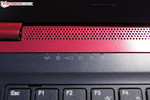
Speakers
The tiny speaker bar that Fujitsu installs into the Lifebook UH572 is of inferior quality. Although the voice output is acceptable, scenarios that go beyond occasional video calls are not possible with it. It lacks both volume and high detail in music playback. Our test tracks were rendered extremely treble-heavy and with a tinny hissing sound.
However, the music quality is acceptable when external loudspeakers or good headphones are connected.
Battery Life
Power Consumption
The idle power consumption of our Fujitsu device is within the average of all tested ultrabooks (5.9 - 8.9 Watts). This is unsurprising since they all feature similar hardware.
The consumption increases up to 40 Watts during load, which is a much worse rate than for example the 33.3 Watts measured in the Aspire S3 or the 35.8 Watts of the Folio 13. However, this result is likely due to the new graphics unit that has to work harder than the old IGP in the latter two devices.
| Off / Standby | |
| Idle | |
| Load |
|
Key:
min: | |
Battery Runtime
The Lifebook is as economic as its contenders in low load, but how is this translated in battery runtime? Can it benefit from the energy efficiency?
Not really, unfortunately. The built-in 42 Wh battery's capacity is somewhat lower than that of the competition. Thus it is unsurprising that the UH572 only lasts for a maximum of 5 hours and 55 minutes in our low load test via the Battery Eater's Reader's benchmark in minimum brightness and with disabled Wi-Fi. HP's Folio 13 relies on a big 59 Wh battery despite a similar case size and price, which can last for 9 hours and 49 minutes remote from the mains.
A similar picture is seen in our standardized Wi-Fi surfing test, where several online media, including YouTube videos, are visited via a script. Of course, Wi-Fi is enabled and the backlight is set to roughly 150 cd/m2 (here the max setting of 2). The Lifebook only survives for 3 hours and 17 minutes, which is not really a bad time. Nevertheless, it is a bit embarrassing for an ultrabook, considering these devices are normally known to stand out by surviving a long Internet session on battery power (HP Folio 13: 5 hours and 5 minutes). For example, really convincing but also more expensive devices like the MacBook Air 13 last for over 6 hours in this test. The average battery life of the compared, low-end contenders is a bit over 4 hours.
The device manages a full-load runtime of 1 hour 41 minutes, which is acceptable considering the battery capacity. (The leader here is again HP's Folio 13 with 2 hours 50 minutes). A somewhat bigger battery would not have hurt the UH572 when compared with the contenders.
Verdict
We praised the Fujitsu Lifebook's relatively good performance rates and the solid build quality of the pretty, red, slim, light and nevertheless rigid magnesium case. But competition never sleeps and mostly delivers stable and slim ultrabooks - but with the difference that they focus on a few important aspects apart from the case in the design and conception process. Battery runtime, keyboard, touchpad, fan management and thermal design are named as a few inadequately resolved points.
It is also too bad that sufficiently bright screens, suitable for outdoor use, are routinely axed away from the blueprints in low-end notebooks and reserved for better paying customers (e.g. Asus' Zenbook UX32VD, Samsung's 900X3B). Fujitsu is going the right way with the matte screen, but content can only be read when the backlight defies the ambient light outdoors as well.
Thus, even when we are willing to accept the existing restrictions of low-end ultrabooks we still want one thing: mobility. If we cannot have a bright screen, we should be allowed to console ourselves with a convincing battery runtime. But the UH572 cannot provide that.
Unfortunately, truly excellent ultrabooks usually cost 500 Euro (~$627) more. But as always true: Comparing is worthwhile. (Top 10 Subnotebooks).


